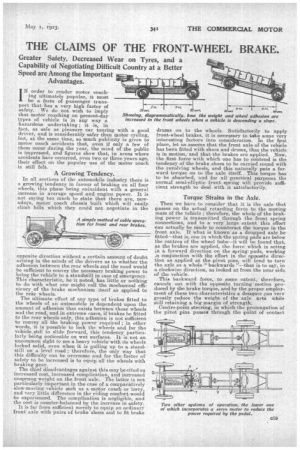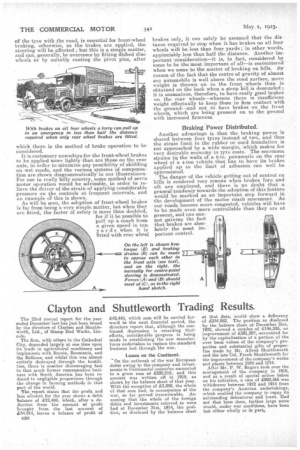THE CLAIMS OF THE FRONT-WHEEL BRAKE.
Page 19

Page 20

If you've noticed an error in this article please click here to report it so we can fix it.
Greater Safety, Decreased Wear on Tyres, and a Capability of Negotiating Difficult Country at a Better Speed are Among the Important Advantages.
IN order to render motor coaching ultimately popular, it must be a form of passenger transport that has a very high factor of safety. We do not wish to imply that motor coaching on present-day types of vehicle is in any way a hazardous undertaking ; it is, in fact, as safe as pleasure car touring with a good driver, and is considerably safer than motor cycling, but, at the same time, so much publicity is given to motor coach accidents that, even if only a few of them occur during the year, the mind of the public is impressed, and figures show that, in areas where accidents have occurred, even two or three years ago, their effect on the popular use of the motor coach is still felt.
A Growing Tendency.
In all sections of the automobile industry there is a growing tendency in favour of braking on all four wheels, this phase being coincident with a general increase in average speed and engine pqwer. It is not saying too much to state that there are, nowadays, motor coach chassis built which will easily climb hills which they could not negotiate in the opposite direction without a certain amount of doubt arising in the minds of the drivers as to whether the adhesion between the rear wheels and the road would be sufficient to convey the necessary braking power to bring the vehicle to a standstill in case of emergency. This characteristic, be it noted, has little or nothing te do with what one might call the mechanical efficiency of the brake mechanism itself as applied to the rear wheels.
The ultimate effect of any type of b.rakes fitted to the wheels of an automobile is dependent upon the amount of adhesion that exists between those wheels and the road, and in extreme eases, if brakes be fitted to the rear wheels only, this adhesion is not sufficient to convey all the braking power required ; in other words, it is possible to lock the wheels and for the vehicle_still to slide forward, this tendency particularly being noticeable on wet surfaces. It is, not an. uncommon sight to see a heavy vehicle with its wheels locked solid, even when it is pulling up to a standstill on a level road ; therefore, the only way that this difficulty can be overcome and for the. factor of safety to be increased is to equip all the wheels with braking gear.
The chief disadvantages against this may be cited as increased cost, increased complication, and increased unsprung weight on the front axle. The latter is not particularly important in the case of a comparatively slow-moving vehicle such as a motor coach or lorry, and very little difference in the riding comfort would be experienced. The complication is negligible, and the cost is counter-balanced by the increase in safety.
It is far from sufficient merely to equip an ordinary front axle with pairs of brake shoes and to fit brake
drums on to the wheels. Satisfactorily to apply front-wheel brakes, it is necessary to take some very interesting factors into consideration. In the first, place, let us assuine that the front axle of the vehicle has been fitted with shoes and drums, that the vehicle is in motion, and that the brakes are applied. Now, the first force with which one has to contend is the tendency of the brake shoes to be carried round with the revolving wheels, and this naturally puts a forward torque on to the axle itself. This torque has to be absorbed, and for all practical purposes the normal semi-elliptic front spring will provide sufficient strength to deal with it satisfactorily.
Torque Strains in the Axle.
Then we have to consider that it is the axle that passes on the actual retarding force to the moving mass of the vehicle ; therefore, the whole of the braking power is transmitted through the front spring connections, and to a very large extent this effort can actually be made to counteract the torque in the front axle. If what is known as a dropped axle be fitted—that is, one in whiclethe spring pads are below tho centres of the wheel hubs—it will be found that, as the brakes are applied, the force which is acting in a forward direction on the spring: pads,. working .n conjunction with the effort in the opposite direction as applied at the pivot pins, will tend to turn the axle as a whole "'backwards "—that is to say, in a clockwise direction, as looked at from the near side of the vehicle.
This backward force, to some extent, therefore, cancels out with the opposite turning 'motion produced by the brake torque, and by the proper employment of these two characteristics' a designer an very greatly reduce the weight of the axle arts While still retaining a big margin of strength.
Centre-point steering, in which the prolongation of the pivot pins passes through the point of contact
of the tyre with the road, is essential for front-wheelbraking, otherwise, as the brakes are applied, the
steering will be affected ; but this is a simple matter, and can, generally, be overcome by fitting dished disc wheels or by suitably canting the pivot pins, after which there is the method of brake operation to be considered.
It is customary nowadays for the front-wheel brakes to be applied more lightly than are those on the rear axle, in order to minimize any possibility of skidding on wet roads, and the various systems of compensation are shown diagrammatically in our illustrations. For use in really hilly country, some method of servo motor operation would be advisable, in order to relieve the driver of the strain of applying considerable pressure on the controls at frequent intervals, and an example of this is shown.
As will be seen, the adoption of front-wheel brakes is far from being a very simple matter, but when they are fitted, the factor of safety is more than doubled, for if it be possible to pull up a coach from a given speed in ten yards when it is fitted with rear wheel brakes only, it can safety be assumed that the dis• tance required to stop when it has brakes on all four wheels win be less than four yards ; in other words, appreciably less than half the distance. Another important 'consideration—it is, in fact, considered by some to be the most important of all—is encountered when we come to the matter of braking on bills. By reason of the fact that the centre of gravity of almost any automobile is well above the road surface, more weight is thrown on to the front wheels than is obtained on the back when a steep hill is descended ; it is anomalous, therefore, to have really good brakes on the rear wheels—whereon there is insufficient weight effectually to keep them in firm contact with the ground—and not to have brakes on the front wheels, which are being pressed on to the ground with increased firmness.
Braking Power Distributed.
Another advantage is that the braking power is shared between four tyres instead of two, and thus the strain limit in the rubber or cord foundation is not approached by a. wide margin, which makes for very desirable economy in tyre costs. The enormous strains in the walls of a 6-in. pneumatic on the rear wheel of a 4-ton vehicle that has to have its brakes applied up to the limit of adhesion can well be appreciated.
The danger of the vehicle getting out of control on hills is rendered very remote when brakes fore and aft are employed, and there is no doubt that a general tendency towards the adoption of this feature would be marked as an important step forwai d in the development of the motor coach movement. As our roads become more congested, vehicles will have to be made even more controllable than they are at present, and one cannot gainsay the fact that brakes are abso-, Iutelv the most important control.
































